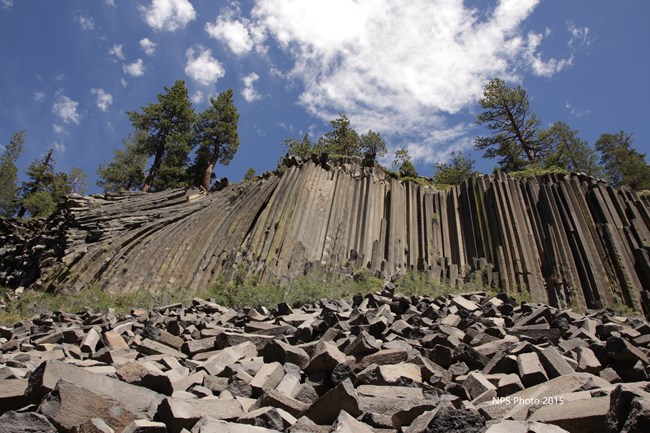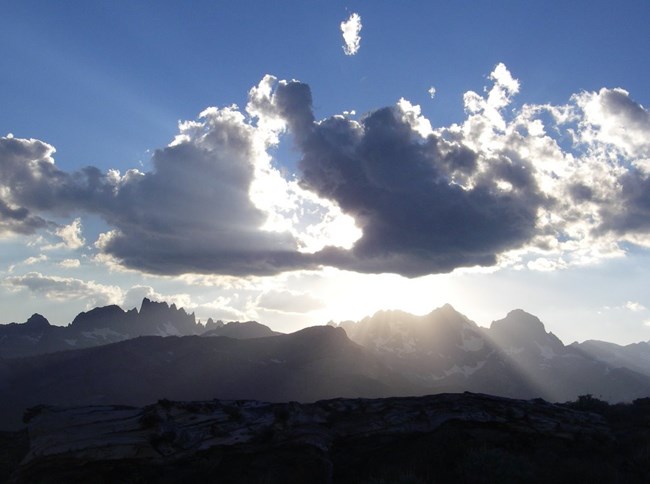
NPS photo Some details of the geologic origin of the Devils Postpile are not completely clear, but enough is known to reconstruct much of the story. Until relatively recently, it was thought to have formed about one million years ago. Current studies suggest that the Postpile was formed less than 100,000 years ago when a cooling lava flow cracked into multi-sided columns. However, to fully understand the geologic setting of the Postpile we must go back millions of years to a time when there was no Sierra Nevada and California was a shallow sea. The beginning of North America For nearly 500 million years, what is now Eastern California was a shallow sea. The western edge of North America was several hundred miles east of the present coastline and North America was part of a large super-continent called Pangaea. This super-continent was the land mass from which all of today’s continents were born. About 200 million years ago, Pangaea began to split and North America began moving to the West while Europe and Asia moved to the East. While all the rifting and moving of Pangaea and North America was taking place, sediments and gravel were steadily eroding from western North American (near present-day Utah and Nevada) and washing out into the shallow sea that covered present-day California. The stage is set for California to arrive As North America drifted westward the adjacent oceanic crust was thrust downward and beneath the moving continent. A north-south subduction zone was born, and for millions of years oceanic crust continued to slam into the westward moving North American continent. Most of the crust slid beneath North America, but occasionally a slice of this sedimentary crust would be thrust onto the continent’s edge. Intermittently, North America would get a big chunk of land added to its western margin as volcanic islands, similar to those of Hawaii or Indonesia, were scraped onto the coast, a process called accretion. These pieces of accreted land are called exotic terranes and the addition of each terrane to North America took millions of years. One such terrane, the Smartville complex, contained the gold veins that would bring wealth and people to the state, some 160 million years later. In this fashion the western edge of North America expanded further and further to the west, and the land we know to be California arrived, piece by piece, like waves from the sea. Mountains begin to rise: The ancestral Sierra Nevada About 140 million years ago, the friction and pressure between the two plates was so great that the land began to crumple and mountains began to rise east of the subduction zone, the ancestral Sierra Nevada was born. During this period of uplift, the accreted terranes and sedimentary layers were twisted, folded and squeezed together and rocks changed from one form to another, a process called metamorphosis. As the mountains rose and great pressures metamorphosed California’s rocks, the subducted crust melted below due to pressure and contact with the Earth’s molten mantle layer. The subducted crust slowly melted from hard rock into magma. In some cases, the magma rose upwards into the continental crust forming large underground magma chambers. Wherever this magma cooled underground (over millions of years) granite formed. Millions of years later this granite would be thrust upwards as the mountains we see today. But not all of the magma cooled underground. Some breached the surface creating volcanoes and fissures, spewing lava of varying types onto land. At this time, the Sierra Nevada would have looked more like the present-day Cascade Mountains of Oregon and Washington or the Andes Mountains of South America. Lasting evidence of this volcanic period is common in the area surrounding Devils Postpile. For instance, the dark green rocks of the Minarets and the Ritter Range were created by a caldera that formed during this time. Hornfels near the Minaret Summit and San Joaquin Ridge are likely from this time period as well. Both of these examples have been highly metamorphosed during the millions of years since their original creation. Though the ancestral Sierra Nevada was rising, it was not nearly as high as the mountains we see today. Many millions of years would pass before the Sierra Nevada would rise to its current elevations. Beginning about 65 million years ago, the ancestral Sierra Nevada began a long period of erosion. The climate was warm and wet at this time, accelerating both chemical and physical erosion processes. Warm shallow seas lapped at the base of the mountains. Rivers carried volcanic and metamorphic rocks and sediments into this shallow sea which is where the Great Central Valley of California lies today. 
NPS photo The Sierra Nevada takes on its present form A renewal of volcanic activity in the Sierra Nevada and Cascades began some 30 million years ago and continues even today. The whole mountain range began tilting to the southwest some 25 million years ago as the Sierra Nevada slowly evolved into its present shape and form. Still, the Sierra was low enough to allow many rivers beginning in present-day Nevada flowed through the mountains en route to the Pacific. The San Joaquin River was one of these. It is believed that the headwaters of the San Joaquin began further to the east in present-day Nevada. About three million years ago a lava flow filled the northern portion of the San Joaquin River Valley isolating the river to areas west of the Sierran crest. Vestiges of this flow are seen in the dark layered, reddish rocks along the San Joaquin Ridge and above the road near Agnew Meadows. These rocks can be seen from the bridge near Devils Postpile, a ¼ mile walk from the Ranger Station. By about 2 million years ago, the Sierra Nevada began rising quite rapidly. The range began tilting westward, uplifting peaks along the eastern edge to elevations comparable with those seen today. The climate became cooler and wetter during these times and as the Sierra Nevada rose higher and higher into the colder elevations, precipitation fell as snow instead of rain. During the intermittent ice ages, so much snow would accumulate that large glaciers formed. Beginning high up in the Ritter Range, glaciers flowed down the Reds Meadow Valley repeatedly throughout these centuries, shaping the valley to near its present form. This most recent period has been one of many dramatic and often opposing forces: volcanoes spewing fiery lava east of the Sierra’s crest, mountains growing curtains of ice along the crest itself, earthquakes thrusting mountains higher and higher, and glaciers grinding mountains into domes. It is within this dramatic context that the Devils Postpile formation came to be. The Postpile begins as a lake of lava An estimated 80,000 to 100,000 years ago a lava vent began spewing hot basaltic lava into the Reds Meadow Valley near present-day Upper Soda Springs, a few miles north of the Monument. Basalt lava is rich in iron and magnesium and is typically much hotter than other types of lava. Because of these traits, basaltic lava tends to have a lower viscosity and will flow more quickly than other lava types. The lava flowed down the valley like a river until it was blocked by a natural dam, probably a glacial moraine left down-valley by a receding glacier during a previous ice age. The lava began filling the valley behind this dam, creating a lava lake 400 ft. deep in some areas. Such depth is uncommon among lava flows and plays a crucial role in the formation of the long columns we see today. The lava cools and cracks reach deep into the formation As the lava flow ceased, the molten rock began cooling into solid rock. Shallow parts of the lava flow would have solidified first, with deeper parts of the lava lake requiring much more time to release the massive amount of stored thermal energy. As the lava lake cooled and solidified from a molten soup to solid rock it began to contract. Contraction stresses developed because the cool solid form of basalt has a lesser volume than the hot liquid form. Cracks, also called joints by geologists, began to form. Jointing releases internal stress created by the cooling and associated contraction. In some locations, such as at the Devils Postpile, the jointing formed columns. Jointing would have begun at the top, bottom and all around the edges of the lava lake where the lava made direct contact with a cooler surface. The cracks would have extended inwards over time as the more insulated locations within the lava lake finally released enough thermal energy to change from a liquid to a solid state. 
NPS photo Powerful forces expose the beauty of the Postpile The Devils Postpile used to be much taller than what we see today. Powerful erosive forces have been at work during the last 80,000 to 100,000 years carving, shaping and demolishing remnants of the lava flow. Freeze-thaw cycles help break apart the columns. Earthquakes knock columns down into the talus slope below. The river slowly eats away at pieces that fall into the water. But no force has left a greater footprint on the Postpile than that of glaciers. In fact, we wouldn’t even see the beautifully straight hexagonal columns hidden within the depths of the lava flow had glaciers not excavated the formation. Several distinct glacial periods have occurred since the Postpile was formed and each has dug deeper and deeper into the dense, heavy rock known officially as basaltic Learn more about local geology |
Last updated: August 5, 2021
